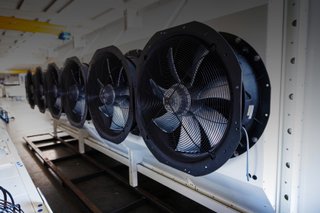
Blast freezer
»Gentlemen, remember one thing - an evaporator and in particular a blast freezer can only be operated economically if it has the worst K-value!«
These were the words of my former lecturer to his confused listeners. When I look back to this event, you realize how much time has passed, 26 years to be precise.
Non the less, little has changed in terms of perspective and physical laws. Except that the subject "refrigeration technology" is luckily no longer a male domain and now the lecturer starts the lecture with "Ladies and Gentlemen".
Today I work in the heat exchanger industry and this “thesis” greatly determines the technology we use in our products evaporators and the blast freezers.
I have learned one thing in the last few years - innovation brings us forward, generally improves price, brings added value, etc. Despite all the euphoria for something new, the basic laws of physics must be fully respected and understanding of the application must be available - in our case the thermodynamics and the application of freezing and cooling.
The heat exchanger technology has also undergone various developments during this time, some of which have advantages in corresponding applications (e.g. slotted (louvred) or embossed fins in clean room applications).
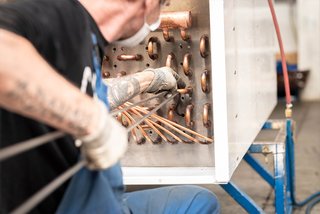
However, these prospective approaches and technologies were unfortunately used incorrectly on applications, generally to allow the price to be kept down in order to compete with the ever-increasing price pressure in this market sector.
This is not the correct way, because ultimately the operator pays for the disadvantages through high operating costs, a lack of functional and operational safety and finally with the reduced productivity of the plant.


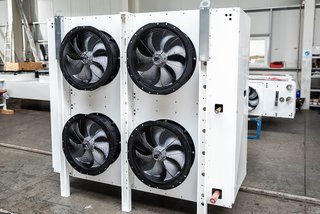

In order to substantiate this claim and to explain the meaning of the statement by my former lecturer mentioned above in a more understandable manner, I would like to explain the phenomenon of thermodynamics in heat exchangers in the product group of the evaporator and in particular the subgroup of the blast freezer in a concrete but simple manner.
You can read on here with confidence - neither a thermodynamic study is required or any overuse of technical terms.
THE BASIC CONSIDERATION FOR BLAST FREEZERS IN THE COLD AIR FREEZING PROCESS IS:
For applications where fast and large freezing capacities are crucial in a confined space.
For rapid cooling and shock freezing, they are mainly used in the food industry, with professionally applied technology, taking into account the needs (air volume flows, different power and temperature levels, etc.) of the respective installation (cooling or quick freezing of meat, fish, poultry, ready meals, baked goods or dairy products), the operator - mainly food manufacturers should to pay attention to ergonomic, economical and reliable air cooler technology.
With most blast freezers, the frozen or chilled goods are positioned directly in front of the heat exchanger. In versions with passing air flow over the heat exchanger, the air flow is distributed in such a way that it exits the heat exchanger evenly and in a horizontal direction.
WHAT IS THE REQUIREMENT FOR THE HEAT EXCHANGER?
Blast freezers mainly work in the sub-zero temperature range. The frozen goods must be cooled down to the desired core temperature in a certain time at a constant temperature with large amounts of air. In short, to guarantee a quick preservation of the goods with a powerful cooling or freezing capacity, this process inevitably leads to the formation of frost on the heat exchanger fins. This condensate or the frost forms from the existing air humidity in the room and from the removal of moisture from the frozen or cooled goods, excessive frost formation acts to a certain extent as an isolator to the heat transfer and also increases air-side pressure loss in the heat exchanger. The consequence of the latter is a drastically reduced air flow (in storage rooms it also influences air distribution).
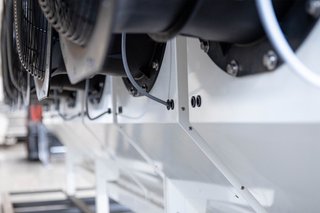
THIS CAN BE EXPLAINED RELATIVELY EASILY USING AN EXAMPLE
Let us assume that we have two aluminum sheets that have the same material specification and thickness, the only difference is that one sheet is only one square meter and the other two square meters, if the same amount of energy were introduced simultaneously to both sheets, the one square meter sheet would have a higher surface or material temperature than the two square meters. If one assumes that the large sheet has twice as much mass as the smaller sheet, the energy input is also distributed over twice as many molecules. Due to the resulting energy distribution, the molecules in the larger sheet are less inclined to react (vibrate). The result of the lower molecular reaction (vibration) is a lower surface or material temperature.
In refrigeration technology, the same principle applies as in the example above - but vice versa. If the same cooling capacity is introduced to both sheets, the larger sheet would have a higher surface temperature e.g. -8 ° C and the smaller e.g. -12 ° C.
If you now pass air over these sheets at the same conditions (air volume, relative humidity, air temperature, atmospheric pressure, etc.), the larger sheet shows that the amount of condensate is much lower.
THE EXPLANATION IS SIMPLE
the higher the temperature difference between the air and the sheet, the higher the formation of condensate or, in our case, frost (p-T diagram, dew point with water vapor partial pressure depending on the relative humidity). The sheets in our example is comparable to the fins on a heat exchanger, however, the surface temperature of a fin not only depends on the exchange surface, but also on the tube pitch (pattern). The example illustrates the differences between an aligned and staggered tube pattern.
Our pattern 55x55 and 55x27.5 with 5/8 “diameter tube is used.
The bottom line of this animation is that the clear spacing of the pipes effects the formation of frost or ice, the formation of frost follows the chaos theory, whereby it can be determined that the first frost starts around the heat exchanger core tubes or fin holes (which sometimes defines the fin spacing) because these points have the lowest temperatures (especially at the ...int of the fan to the so-called break point.
If the surface temperature of the fins is lower due to the smaller exchange surfaces (larger temperature difference between the air inlet temperature and the surface temperature of the fins), even more condensate or frost will form. The frost mainly occurs, as already mentioned, around the heat exchanger core tubes and, of course, also on the fin surface.
A smaller exchange area means not only more condensation, but also faster growth of frost, the consequence of this is that the free inflow area, which is defined by the lamella spacing, is also reduced, the reason is that more condensate in the form of frost settles on an area that is too "small" the frost is inevitably built up in layers, so-called frost thickness! The higher the frost thickness, the smaller the clear distance between the frosted fins (e.g. 9.75 mm clear distance between fins when dry - with 1 mm frost on each side, the clear distance shrinks to 7.75 mm).
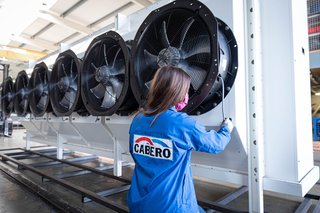
WHAT DOES THIS MEAN FOR A BLAST FREEZER?
All blast freezers work with additional air-side pressure losses (50-250 Pa), which are caused by the deflection of the air mass and reduced flow areas on food shelving or other refrigerated goods carriers.
A "disadvantageous" heat exchanger technology, which results in a stronger formation of frost, in combination with the additional external pressure losses, changes the operating point of the fan and consequently reduces the required air mass flow (air volume). The consequence are that the expansion valve opens and lower evaporation temperatures are set in order to compensate for the heat transfer resistance and the formation of frost is increased, this increases the load on the compressor and the associated electrical consumption.
As a result of both phenomena, the air mass flow and the air outlet temperature are very inconsistent and the frozen food could be damaged by air outlet temperatures that are too low and / or the freeze cycles cannot be kept to the required period of time and If the evaporation temperature drops further, defrosting is also required.
CAN YOU INCREASE THE EXCHANGE AREA BY REDUCING THE FIN SPACING?
I was often asked this question as a logical consequence. The distance between fins is mainly determined from the application. Various criteria play a role, such as Evaporation temperatures, cold room temperature, heat input and relative humidity, etc.
Would a manufacturer with the same or similar inflow surface have e.g. Offer 10 mm fin spacing based on the application and the other to achieve the same heat exchange area ratio e.g. Using 7.5 mm, one could safely assume that several additional defrost cycles will be necessary with the reduced fin spacing, however, the pipe division is also decisive, which is determined by the efficiency of the heat exchanger.
It should also be noted that smaller fin spacings with similarly finned depths and inflow surfaces on the heat exchanger always lead to higher air-side pressure losses even in the non-frosted state.
Embossing the fin to reduce the amo... such as slotted (louvred), pyramidal, etc. on the evaporator or blast freezer is to be regarded as counterproductive.
The primary purpose of the embossing is to subject the air layers between the fins to a high degree of turbulence to optimize the heat transfer and to achieve smaller exchange areas and to reduce the use of materials.
As already explained above, the reduction in exchange area results in greater frost formation. If the frost also forms over the embossing - such as slit type - the frost closes it and the effect of turbulence generation is no longer there. The consequence would be a high and, above all, rapid drop in cooling capacities, which could only be "remedied" to a certain extent by more defrosting phases. The additional energy required by defrosting, the heat input into the cooling room and the higher energy costs at the compressor are already a blatant disadvantage, whereas the reduced availability of the system should be the actual cost factor.
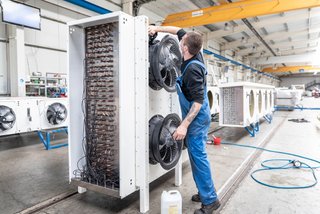
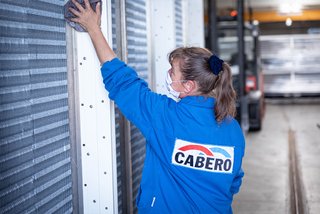
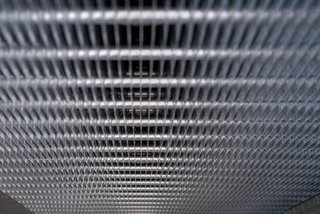
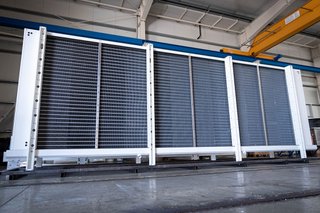
CONCLUSION
My professor was completely right. The K-value or U-value is largely determined by the area and the middle logarithmic temperature difference. In the latter, the amount of air (mass air flow) indirectly plays a decisive role, because it determines the temperature difference between the air inlet and outlet air temperatures.
If you want to reduce the condensate or frost, you must operate with a small temperature difference between the air inlet and fin surface temperature, this can only be achieved by using suitable pipe patterns and in particular larger exchanger area. Large exchange areas mean, however, that the U-value (U-value = Q / (middle log. Temp.-diff x A)) drops.
The same applies to "blast coolers" which work at positive temperatures and are primarily intended to reduce the temperature of the refrigerated goods. However, there is also the fact that less condensate also means less moisture removal from the refrigerated goods, which in turn means less weight loss and better product quality.